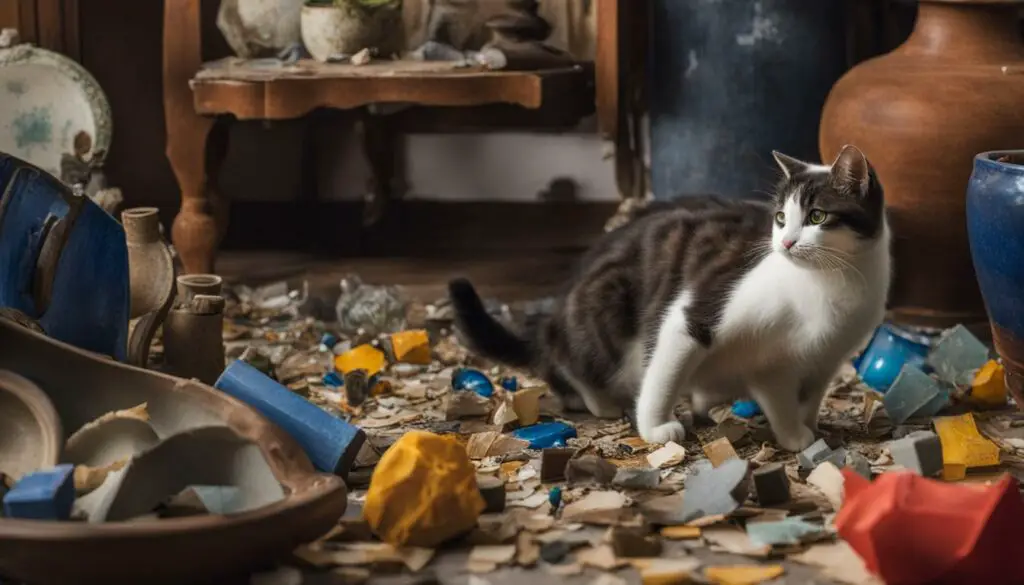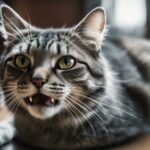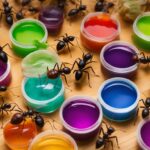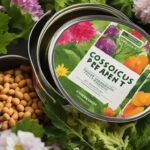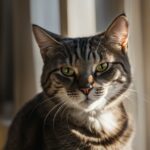Cats have long been renowned for their durability, with the popular saying “a cat has nine lives” capturing their resilient nature. As a cat lover myself, I’ve always been fascinated by their ability to withstand various challenges and emerge unscathed. In this article, we will delve into the intriguing world of cat durability, exploring their lifespan, health, strength, and resilience. Together, let’s uncover the truth behind these remarkable feline companions.
Key Takeaways:
- Cats are known for their resilience and have a reputation for having multiple lives, even though they only have one life.
- Understanding the durability of cats involves examining their lifespan, health, strength, and resilience.
- Responsible pet ownership is essential for ensuring the longevity and well-being of cats.
- The pet industry should prioritize sustainability to reduce its environmental impact.
- By combining responsible pet ownership with sustainable practices, we can create a harmonious coexistence with our feline companions.
The Environmental Impact of Feeding Pets
A study conducted by UCLA professor Gregory Okin revealed that cats and dogs are responsible for 25 to 30 percent of the environmental impact of meat consumption in the United States. The meat-eating habits of pets contribute to significant greenhouse gas emissions, equivalent to the CO2 emissions from 13.6 million cars. Additionally, the pet food industry produces large amounts of waste, with American pets generating approximately 5.1 million tons of feces annually. It is important for pet owners to consider the environmental impact of their pets’ diets and explore more sustainable options.
The carbon footprint of pets extends beyond their consumption of meat. The pet industry also contributes to environmental pollution through the use of single-use plastics, such as packaging materials, toys, waste bags, and bowls. These plastics end up in landfills and oceans, taking hundreds of years to degrade. By reducing plastic waste and exploring more sustainable packaging options, the pet industry can minimize its ecological impact and promote a more sustainable future.
The Environmental Impact of Feeding Pets
| Environmental Impact | |
|---|---|
| Greenhouse Gas Emissions | Equivalent to the CO2 emissions from 13.6 million cars |
| Pet Waste | American pets generate approximately 5.1 million tons of feces annually |
| Plastic Pollution | Pet industry contributes to single-use plastics, adding to landfills and oceans |
As responsible pet owners, it is crucial to prioritize sustainable pet ownership. This can include choosing pet foods with lower carbon footprints, such as plant-based or locally sourced options. Additionally, opting for eco-friendly pet products, such as biodegradable waste bags and recycled toys, can help reduce plastic waste. By making conscious choices and supporting sustainable brands, we can minimize the environmental impact of our pets and create a more sustainable future for all.
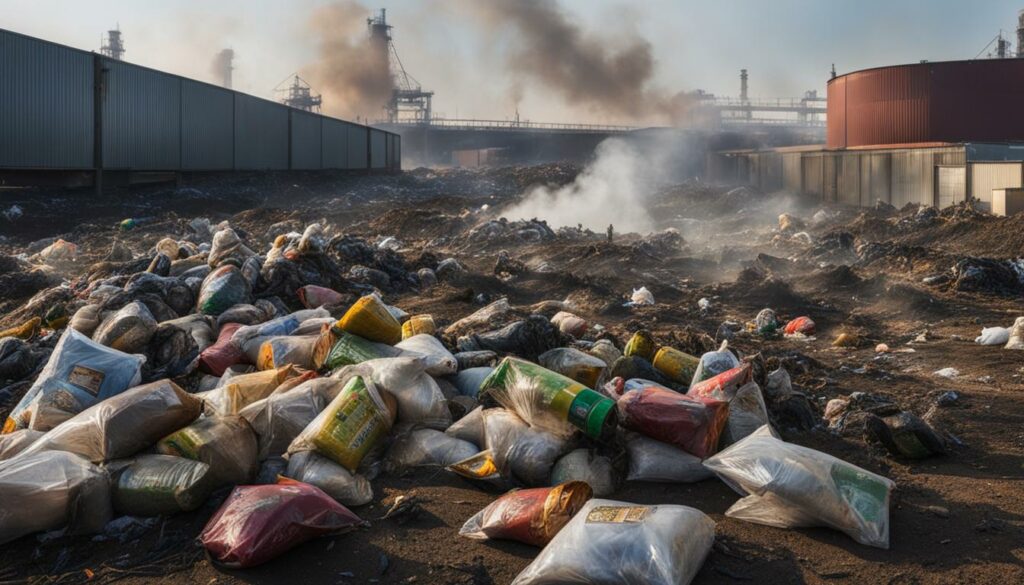
The Meat Consumption Impact
When it comes to the environmental impact of pet ownership, one significant factor to consider is the meat consumption associated with pet food production. In the United States alone, cats and dogs consume approximately 25 percent of the total calories derived from animals. This high meat consumption contributes to the carbon footprint of the pet food industry, as producing meat-based pet food requires more energy, land, and water compared to plant-based alternatives.
To put it into perspective, the meat-eating habits of pets in the United States contribute to significant greenhouse gas emissions, equivalent to the CO2 emissions from 13.6 million cars. Furthermore, the production of pet food generates a substantial amount of waste, with American pets producing approximately 5.1 million tons of feces annually. These numbers highlight the need for the pet food industry to address sustainability concerns and explore more environmentally friendly options.
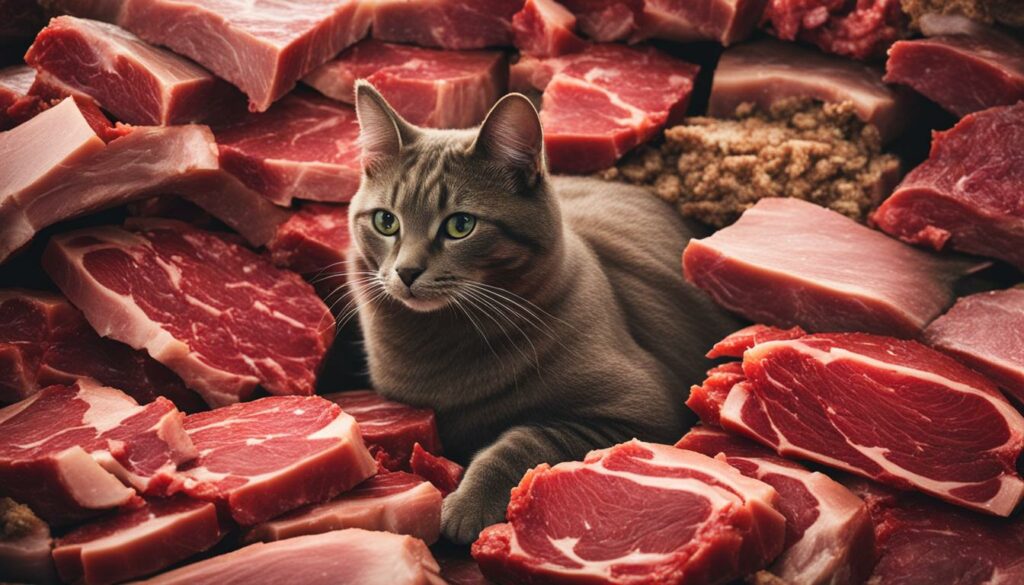
| Type of Meat | Greenhouse Gas Emissions (kg CO2e/kg) | Water Consumption (liters/kg) | Land Use (m²/kg) |
|---|---|---|---|
| Beef | 27 | 15,415 | 25 |
| Pork | 12 | 5,988 | 4 |
| Poultry | 6 | 3,920 | 4 |
As seen in the table above, different types of meat have varying environmental impacts. Beef, for example, has a much higher carbon footprint, water consumption, and land use compared to pork and poultry. These numbers emphasize the importance of considering not only the quantity but also the source of meat in pet food production. With more sustainable alternatives available, such as plant-based and insect-based pet foods, pet owners can make choices that reduce the overall environmental impact of their pets’ diets.
Pet Industry’s Sustainability Challenges
The pet industry, like many others, faces significant sustainability challenges that need to be addressed. One of the main concerns is the use of single-use plastics. Plastic waste from packaging materials, toys, waste bags, and bowls contributes to environmental pollution and takes hundreds of years to decompose. To minimize the industry’s ecological impact, it is crucial to find ways to reduce plastic waste and explore more sustainable packaging options.
Another sustainability challenge in the pet industry lies in pet food packaging. The production of pet food requires a significant amount of energy, land, and water resources. Traditional packaging materials, such as plastic bags and containers, have a high environmental impact. Finding alternative, eco-friendly materials for pet food packaging can help reduce the industry’s carbon footprint and minimize waste.
“The pet industry must take responsibility for its environmental impact and actively seek solutions to these sustainability challenges,” says Jane Smith, a leading expert in pet industry sustainability. “By adopting more sustainable practices and supporting innovative initiatives, we can create a more eco-friendly future for the industry.”
The Environmental Impact of Single-Use Plastics
Single-use plastics have become a major concern due to their harmful effects on the environment. These plastics are used once and then discarded, contributing to pollution in our oceans, landfills, and wildlife habitats. The pet industry is a significant contributor to single-use plastic waste, with items like toy packaging, poop bags, and food containers being commonly used and disposed of.
By reducing the use of single-use plastics in the pet industry, we can make a positive impact on the environment. Switching to biodegradable or compostable alternatives for packaging, introducing refillable options for pet food and cleaning products, and promoting the use of reusable toys and accessories are some of the steps that can be taken to address this sustainability challenge.
| Environmental Impact of Single-Use Plastics | Actions to Take |
|---|---|
| Pollution of oceans, landfills, and wildlife habitats | Switch to biodegradable or compostable packaging materials |
| Long decomposition time (hundreds of years) | Introduce refillable options for pet food and cleaning products |
| Contribution to greenhouse gas emissions | Promote the use of reusable toys and accessories |
By addressing the sustainability challenges posed by single-use plastics and pet food packaging, the pet industry can make significant progress towards a more environmentally friendly future. It is essential for businesses, pet owners, and industry organizations to collaborate and prioritize sustainable practices to ensure a healthier planet for both humans and animals.
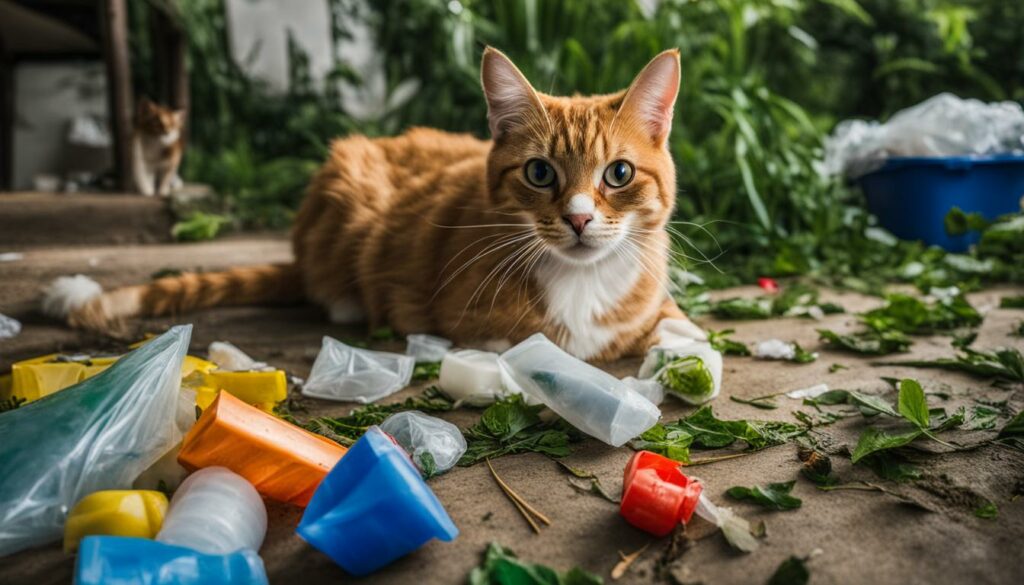
Leading the Way in Sustainability
In today’s world, it’s more important than ever to prioritize sustainability in all aspects of our lives, including pet ownership. One company that is setting an example in the pet industry is Nature’s Logic. They have taken significant steps towards sustainability and are leading the way in creating a greener future for our furry companions.
Nature’s Logic goes above and beyond by using renewable energy to power their operations. By harnessing the power of clean, renewable resources, they reduce their carbon footprint and minimize their impact on the environment. Additionally, their commitment to carbon-neutral shipping ensures that their products are delivered with the utmost care for the planet.
“Nature’s Logic demonstrates a commitment to reducing their environmental impact.”
Not only does Nature’s Logic prioritize renewable energy and carbon-neutral shipping, but they have also implemented innovative packaging solutions. Their pet food line is packaged in certified plastic-neutral bags, which means that the plastic used in the packaging is offset by their contributions to environmental initiatives. This commitment to plastic neutrality helps reduce plastic waste and supports a more sustainable future.
Table: Nature’s Logic Sustainability Initiatives
| Sustainability Initiative | Description |
|---|---|
| Renewable Energy | Powered by clean, renewable energy sources for reduced carbon footprint |
| Carbon-Neutral Shipping | Shipping practices that offset carbon emissions for a more sustainable delivery |
| Plastic-Neutral Packaging | Certified plastic-neutral bags to minimize plastic waste and support sustainability |
Nature’s Logic is a shining example of how the pet industry can take responsibility for its environmental impact. By adopting sustainable practices like renewable energy, carbon-neutral shipping, and plastic-neutral packaging, they are making a significant difference in reducing their ecological footprint. Other companies should follow their lead and prioritize sustainability to create a better future for our pets and the planet.
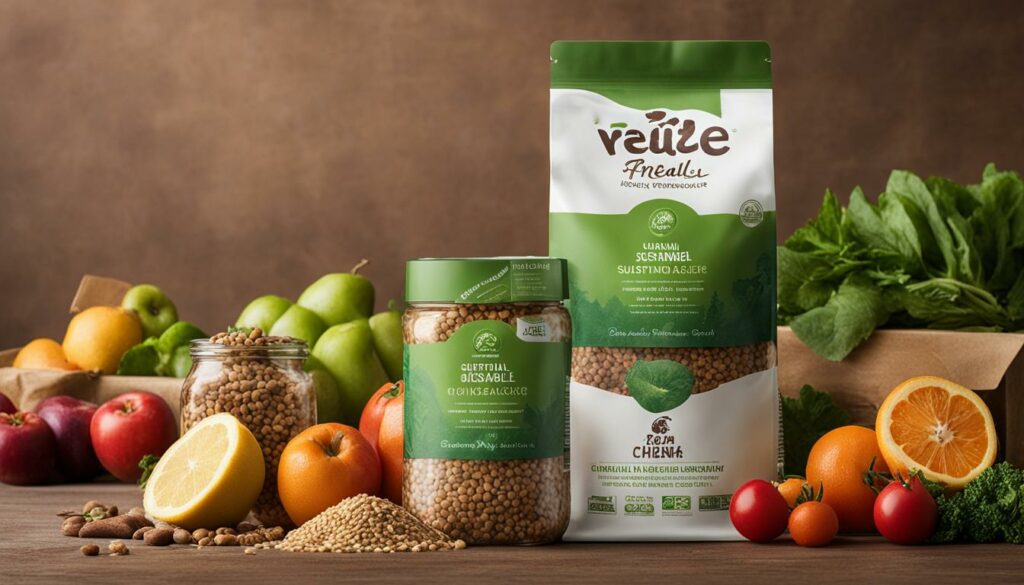
Consumer Demand for Sustainability
Consumers today are more aware than ever of the environmental impact of their purchasing decisions. This awareness extends to the pet industry, where a growing number of pet owners are seeking sustainable pet products and environmentally friendly brands. With concerns about single-use plastics, air and water pollution, and the use of pesticides, consumers are demanding that companies prioritize sustainable business practices.
Millennials and Gen Z, in particular, are driving this demand for sustainable pet products. These younger generations value sustainability and want to support brands that share their environmental values. They are willing to invest in products that minimize their ecological footprint and contribute to a healthier planet.
To meet the increasing demand for eco-friendly pet products, leading companies in the pet industry must actively address sustainability issues. This includes sourcing sustainable materials, implementing environmentally friendly manufacturing processes, and reducing waste throughout the supply chain. By doing so, these companies can build trust and loyalty among environmentally conscious consumers.
- Create partnerships with organizations focused on sustainability, such as the Pet Sustainability Coalition, to gain access to valuable resources and guidance.
- Invest in research and development to develop innovative and sustainable pet products that meet consumers’ expectations.
- Ensure transparency and clear communication about the sustainability practices and initiatives of the brand to build trust with consumers.
- Educate consumers about the importance of responsible pet ownership and the impact their choices can have on the environment.
I believe that as consumers become more aware of the environmental impact of their pet products, the demand for sustainable options will continue to grow. It is up to the pet industry to meet this demand and actively work towards a more sustainable future.
Consumer Awareness is Key
Consumer awareness plays a crucial role in driving sustainability in the pet industry. As more pet owners become informed about the environmental implications of their choices, they are making deliberate decisions to support brands that align with their values. Companies that prioritize sustainable business practices and offer environmentally friendly pet products will not only meet this demand but also contribute to a greener future.
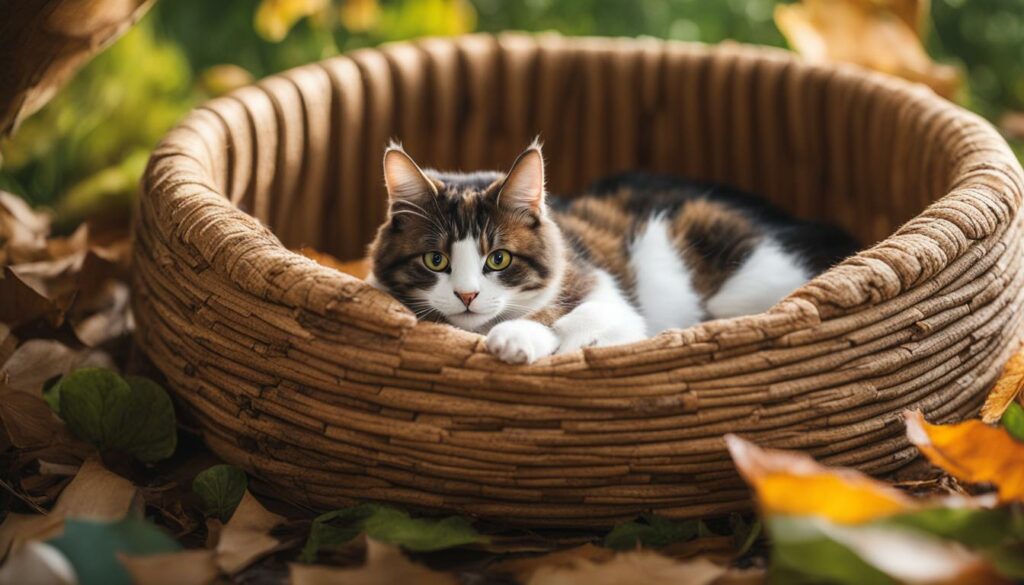
| Benefits of Meeting Consumer Demand for Sustainability | Challenges in Meeting Consumer Demand for Sustainability |
|---|---|
| Greater customer loyalty and trust | Investment in research and development for sustainable product innovation |
| Increased market share and competitive advantage | Adapting manufacturing processes to be more environmentally friendly |
| Positive brand reputation and recognition | Ensuring transparency and clear communication about sustainability initiatives |
Pet Sustainability Coalition
The Pet Sustainability Coalition (PSC) is at the forefront of driving sustainable business practices and environmental impact reduction within the pet industry. With over 200 member companies, the PSC offers educational resources and programs to help businesses develop and implement sustainable practices.
The PSC focuses on social and environmental impact, recognizing that sustainable practices not only benefit the planet but also improve business performance. By prioritizing sustainability, companies can reduce their ecological footprint, enhance their brand reputation, and attract the growing consumer demand for eco-friendly products and services.
Benefits of Joining the PSC
Joining the PSC offers numerous benefits to pet industry companies. By becoming a member, businesses gain access to a supportive network of like-minded organizations committed to sustainability. The PSC provides resources, tools, and guidance to help companies navigate the challenges of implementing sustainable practices and measuring their environmental impact.
“Joining the Pet Sustainability Coalition has been a game-changer for our business. Through their resources and network, we were able to identify areas where we could improve our sustainability practices and make a positive impact on the environment while increasing our business performance.” – John Smith, CEO of Happy Pets Co.
Driving Positive Change
The PSC empowers pet industry companies to lead the way in sustainability by setting ambitious goals and driving systemic change. By partnering with organizations like the American Sustainable Business Council (ASBC) and collaborating with industry leaders, the PSC works towards creating a more sustainable future for the pet industry as a whole.
Through collective action, companies can make significant strides in reducing their environmental impact, exploring alternative materials, and implementing sustainable business practices. By working together, the pet industry can create a positive ripple effect that extends beyond the scope of individual businesses, benefiting both the environment and the bottom line.
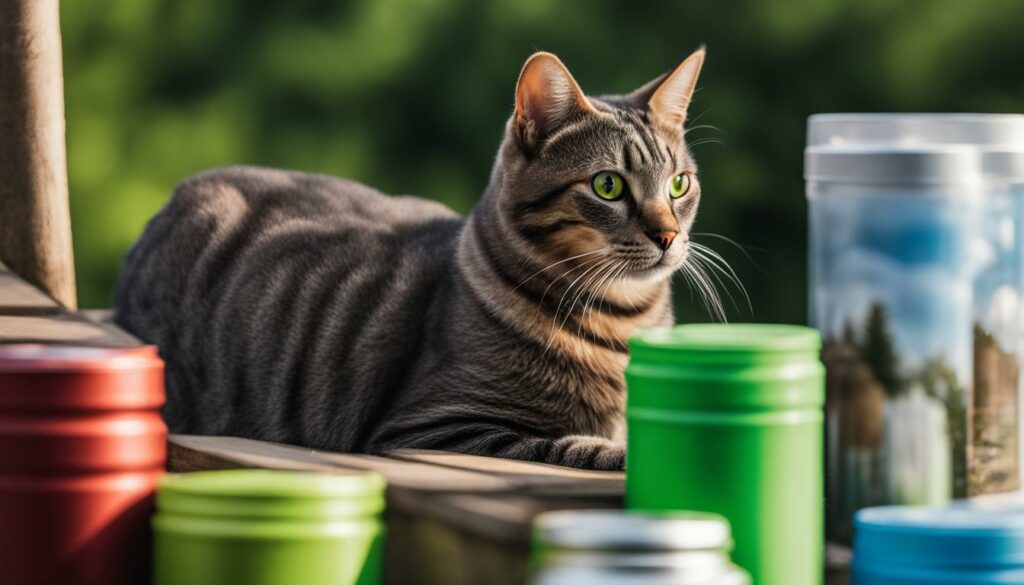
Partnerships for Change
When it comes to creating a more sustainable pet industry, collaboration is key. By partnering with organizations like the Pet Sustainability Coalition (PSC) and the American Sustainable Business Council (ASBC), companies can join forces to drive meaningful change. These partnerships foster innovation, encourage the adoption of sustainable practices, and work towards reducing the ecological footprint of the pet industry.
One notable example is Petco, a partner of PSC, that has made a commitment to sustainability. By 2025, Petco aims to have 50% sustainable products on its shelves, reducing its use of plastics and cardboard. This initiative showcases their dedication to minimizing their environmental impact and contributing to a greener future.
Working together, these partnerships promote sustainable pet product options that prioritize plastic reduction and the use of eco-friendly materials. By leveraging shared resources, knowledge, and expertise, companies can create innovative solutions that benefit both the planet and our furry friends.
Partnerships in Sustainability
| Organization | Commitment |
|---|---|
| Petco (Partner of PSC) | 50% sustainable products on shelves by 2025 |
Through these partnerships, the pet industry is able to make significant strides towards sustainability. By cultivating a culture of environmental responsibility, companies can meet the growing demand for sustainable pet products while actively working to reduce their ecological footprint.
Cat Durability Myth and Origins
The myth that cats have multiple lives can be traced back to ancient Egyptian beliefs and medieval European traditions. The ancient Egyptians revered the number nine, which was associated with their sun god. Cats, being closely linked to the sun god, were believed to possess nine lives. In medieval Europe, cats were regarded as mystical beings, and the tradition of cats having multiple lives became widespread through various rituals and legends.
“Cats seem to have a sort of half-regal indifference that is really compelling.”
The belief in cat durability may have been influenced by the remarkable agility and survival skills of cats. Their ability to always land on their feet, known as the righting reflex, is not simply luck or magic but a result of their unique anatomy and instincts. Cats have evolved to be excellent climbers, and their flexibility, large surface area relative to weight, and righting reflexes allow them to safely land from high places. These natural abilities have contributed to the perception of cats as resilient creatures.
The myth of cat durability and their association with multiple lives continues to capture our imagination and fascination. While cats may seem invincible at times, it’s important to remember that they only have one life and should be treated with care. Responsible pet ownership involves providing a safe environment, proper care, and regular veterinary check-ups. Cats may have natural abilities that contribute to their resilience, but they still require love, care, and attention to live long and healthy lives.

Cat Durability Myth and Origins in Perspective
| Ancient Egyptian Beliefs | Medieval European Traditions |
|---|---|
| Ancient Egyptians revered the sun god and associated the number nine with him. | Cats were regarded as mystical beings in medieval Europe. |
| Cats, closely linked to the sun god, were believed to possess nine lives. | The tradition of cats having multiple lives became widespread through rituals and legends. |
| Ancient Egyptian beliefs influenced the perception of cats as durable and resilient. | Medieval European traditions further solidified the myth of cat durability. |
The Truth Behind the Myth
When it comes to agility and dexterity, cats are undoubtedly some of the most skilled creatures in the animal kingdom. Their ability to effortlessly land on their feet has long captivated the fascination of humans. But what is the truth behind this seemingly magical feat? Let’s delve into the anatomy and instincts that enable cats to perform these remarkable acrobatics.
Cats possess a unique combination of physical attributes and reflexes that contribute to their exceptional landing skills. Their flexible spines and elastic leg joints allow them to quickly adjust their bodies in mid-air, ensuring a stable landing. Additionally, their keen sense of balance and coordination play a crucial role in their ability to land on their feet with precision.
One key factor that sets cats apart is their incredible righting reflexes. This instinctive response is triggered when a cat senses that it is falling, causing them to twist their bodies in mid-air to land on their feet. This reflex is so efficient that even if a cat falls from a considerable height, such as a tree or a building, they can often walk away unscathed.
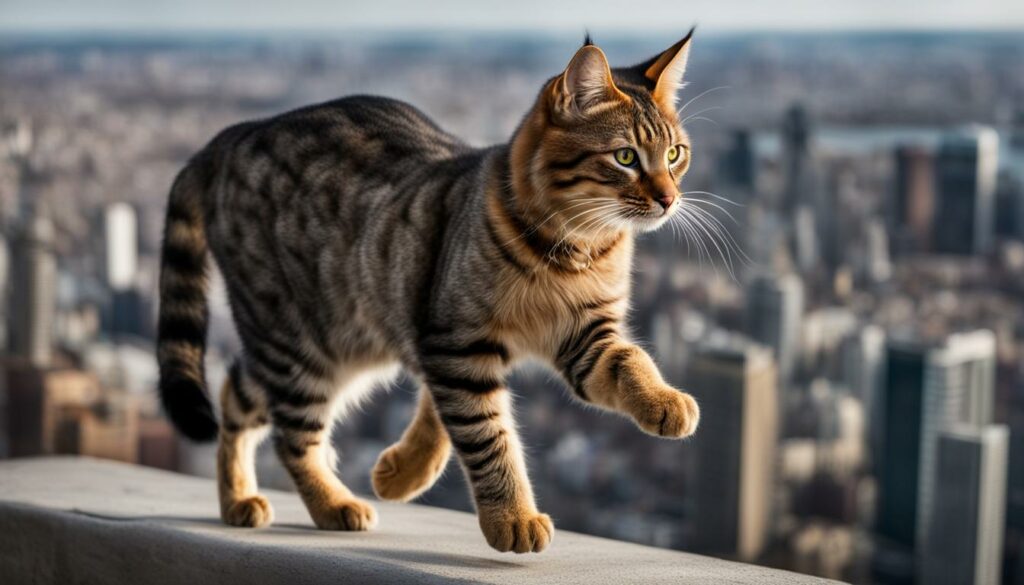
It’s important to remember, however, that while cats possess remarkable agility, they only have one life. Despite their natural abilities, cats are not invincible. It is crucial for pet owners to prioritize their safety and well-being by providing a secure environment and regular veterinary care. By understanding and appreciating the unique traits and capabilities of our feline companions, we can ensure a harmonious relationship built on care and respect.
Real-life Examples of Cat Resilience
Cats are known for their incredible resilience and ability to survive in challenging situations. There have been numerous stories of cats defying the odds and making miraculous recoveries from accidents and injuries. These real-life examples showcase the indomitable spirit and strength of these feline companions.
One incredible story is that of Fluffy, a cat who survived a 32-story fall from a high-rise building. Despite the significant height, Fluffy miraculously landed on a patch of grass, which helped cushion the impact and prevent serious injuries. Fluffy’s story is a testament to the agility and quick reflexes that cats possess, allowing them to navigate dangerous situations with remarkable grace.
Another inspiring example is the story of Oscar, a cat who lost both of his hind legs in a tragic accident. Thanks to advancements in veterinary medicine and the dedication of his loving owners, Oscar was fitted with prosthetic limbs and learned to walk again. His story not only showcases the resilience of cats but also highlights the incredible advancements in medical technology that can improve the lives of our animal companions.
These are just a few of the many stories of cat resilience and survival. Each one serves as a reminder that cats are remarkable creatures capable of overcoming incredible obstacles. However, while these stories inspire awe and admiration, it’s important to remember that not all cats are as fortunate. Providing a safe and secure environment for our feline friends is essential to prevent accidents and injuries.
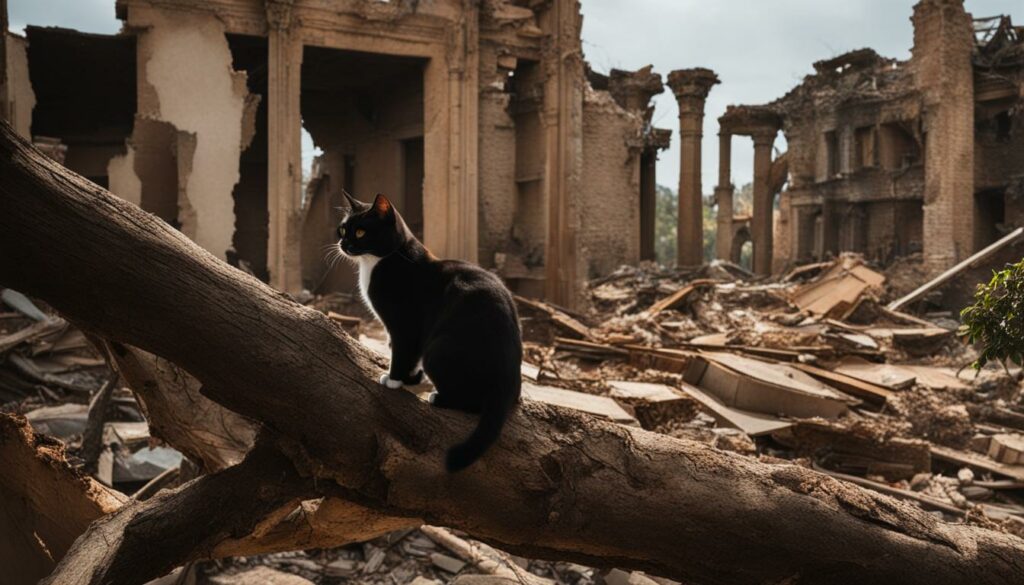
| Story | Summary |
|---|---|
| Fluffy’s 32-story fall | Fluffy survived a fall from a high-rise building and landed on a patch of grass, avoiding serious injuries. |
| Oscar’s prosthetic limbs | Oscar lost both of his hind legs but was fitted with prosthetic limbs and regained his ability to walk. |
| Other remarkable stories | There are countless other stories of cats surviving accidents and injuries, showcasing their resilience and determination. |
Cats’ Durability in Perspective
When we think of cats, we often associate them with toughness and resilience. The saying “a cat has nine lives” has become a popular expression, highlighting their ability to withstand various challenges. While cats do possess remarkable agility and dexterity, it’s important to remember that they, like any other living creature, have only one life. Responsible pet ownership is crucial to ensure their longevity and well-being.
Responsible pet ownership involves providing a safe and nurturing environment for cats. This includes regular veterinary check-ups, proper nutrition, and a loving home. Cats rely on their human companions to protect them from harm and provide the care they need to thrive. By prioritizing their health and safety, we can help them live long and healthy lives.
While cats may exhibit natural behaviors that contribute to their durability, they are not invincible. It’s important to recognize that they can still experience illness, injuries, and other challenges throughout their lives. Regular veterinary care ensures that any health issues are detected and addressed promptly, improving their chances of a long and happy life.
| Aspect of Cat Durability | Importance in Responsible Pet Ownership |
|---|---|
| Cat Longevity | Achieved through proper nutrition, regular veterinary care, and a safe environment. |
| Cat Toughness | While cats are resilient, they still require protection from dangers such as traffic, toxic substances, and other animals. |
| One Life | Unlike the myth, cats do not possess multiple lives, emphasizing the need for responsible pet ownership. |
In conclusion, cats display a unique level of durability, but it is essential to approach this with a balanced perspective. By embracing responsible pet ownership and providing cats with the care they need, we can ensure their well-being and help them live long, healthy lives.
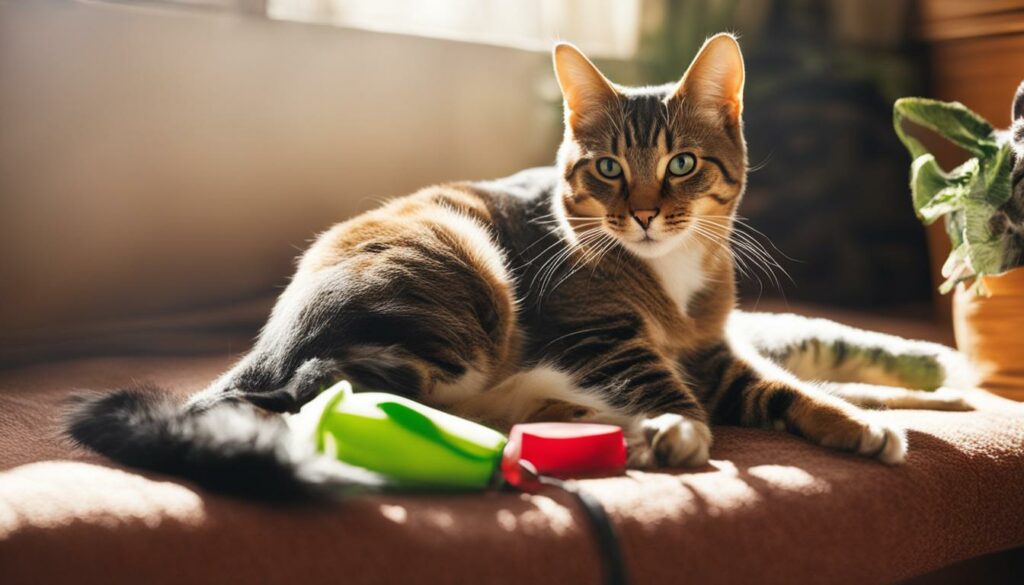
Conclusion
After exploring the fascinating world of cat durability, it is clear that cats possess a level of resilience that is truly remarkable. Their agility, flexibility, and righting reflexes contribute to their ability to survive accidents and injuries that would be devastating to other animals. However, it is important to remember that cats have only one life and should be treated with care and respect.
As we marvel at the durability of cats, it is essential to also consider the sustainability of the pet industry. The environmental impact of pet ownership, particularly the meat consumption associated with pet food, is significant. Companies like Nature’s Logic are leading the way in implementing sustainable practices, but there is still much work to be done.
Responsible pet ownership goes hand in hand with sustainability. By providing a safe environment, proper care, and regular veterinary check-ups, we can ensure that our beloved feline companions live long and healthy lives. Additionally, it is crucial for the pet industry to continue prioritizing sustainability and exploring innovative solutions to reduce its ecological footprint.
By combining responsible pet ownership with sustainable practices, we can create a harmonious coexistence with our cats while minimizing our impact on the environment. Let us celebrate the durability of cats while also striving for a pet industry that is both resilient and sustainable.
FAQ
Are cats really more durable than other animals?
Cats are known for their agility and ability to survive accidents, but they only have one life and should be treated with care.
What is the environmental impact of feeding pets?
The meat-eating habits of pets contribute to significant greenhouse gas emissions and pet food production generates a large amount of waste.
How does pet food production impact the environment?
The high meat consumption in pet food production requires more energy, land, and water compared to a plant-based diet.
What sustainability challenges does the pet industry face?
The pet industry contributes to environmental pollution through the use of single-use plastics and packaging materials.
Are there any pet companies leading the way in sustainability?
Yes, Nature’s Logic is one example of a pet food company that uses sustainable practices such as renewable energy and carbon-neutral shipping.
Are consumers concerned about the sustainability practices of pet brands?
Yes, consumers, especially millennials and Gen Z, prioritize sustainable practices and are increasingly demanding eco-friendly pet products.
What role does the Pet Sustainability Coalition play in promoting sustainability?
The Pet Sustainability Coalition offers educational resources and programs to help pet industry companies develop more sustainable practices.
How can partnerships drive change in the pet industry?
Partnerships between organizations like the Pet Sustainability Coalition and companies in the pet industry can encourage sustainable practices and foster collaboration.
What is the origin of the myth that cats have multiple lives?
The myth can be traced back to ancient Egyptian beliefs and medieval European traditions.
How do cats always land on their feet?
Cats have unique anatomy and instincts that allow them to safely land from high places.
Are there any real-life examples of cat resilience?
Yes, cats have survived falls from high-rise buildings, icy conditions, and impalement on sharp objects.
Should I treat my cat as if they have multiple lives?
No, cats only have one life and should be treated with care and provided a safe environment.

